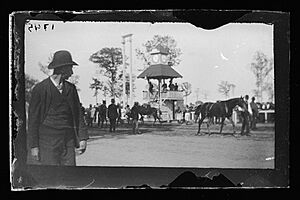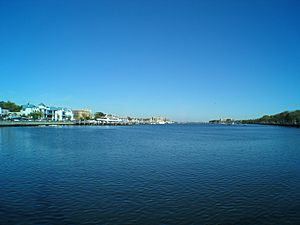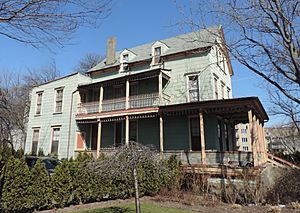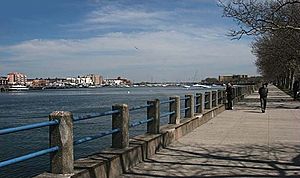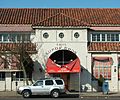Sheepshead Bay, Brooklyn facts for kids
Quick facts for kids
Sheepshead Bay
|
|
|---|---|
|
Neighborhood
|
|
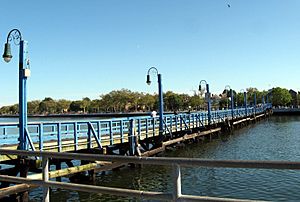
Ocean Avenue Footbridge
|
|
| Country | |
| State | |
| City | |
| Borough | Brooklyn |
| Community District | Brooklyn 15 |
| Area | |
| • Total | 2.2800 sq mi (5.9053 km2) |
| Population
(2010)
|
|
| • Total | 64,518 (103,834 with Madison subsection) |
| Ethnicity | |
| • White | 68.1% |
| • Asian | 15.7 |
| • Hispanic | 8.1 |
| • Black | 6.4 |
| • Other | 1.7 |
| Time zone | UTC−5 (Eastern) |
| • Summer (DST) | UTC−4 (EDT) |
| Area code | 718, 347, 929, and 917 |
Sheepshead Bay is a neighborhood in southern Brooklyn, New York City. It's a lively area known for its waterfront and community feel. The neighborhood gets its name from the bay it sits next to. This bay separates mainland Brooklyn from parts of Coney Island and Manhattan Beach.
Sheepshead Bay is surrounded by other neighborhoods like Brighton Beach, Manhattan Beach, Coney Island, and Homecrest. It's also near Midwood and Gerritsen Beach. The area is part of Brooklyn Community Board 15 and has two main ZIP Codes: 11229 and 11235. The local police department is the 61st Precinct of the New York City Police Department.
Contents
History of Sheepshead Bay
From Fishing Village to Tourist Spot
The name "Sheepshead Bay" comes from a type of fish called the sheepshead. These edible fish were once common in the bay's waters. Long ago, Sheepshead Bay was a quiet place. It was a small community focused on fishing and farming.
In the 1840s, people from Brooklyn and Manhattan started visiting Sheepshead Bay. They came for summer fun, especially for hunting and fishing. This led to new restaurants and hotels being built. The area became even more popular when Ocean Avenue opened in 1876. Also, a train line, the Long Island Rail Road's Manhattan Beach Branch, started bringing visitors in 1877–1878. This train brought people to both Sheepshead Bay and the Manhattan Beach resort nearby.
In 1880, the Sheepshead Bay Race Track opened. This brought even more visitors during the spring and fall. Wealthy people built fancy homes on Emmons Avenue, which was called "Millionaire's Row."
Changes and Growth of the Area
The race track stopped horse racing in 1910 because horse betting became illegal in New York. It then became an auto racing track for a few years. After the race track closed, and with new amusement parks opening in nearby Coney Island, Sheepshead Bay became less of a tourist spot. The train service also stopped in 1924.
The land where the race track used to be was sold for new houses. This brought many new residents to Sheepshead Bay. The fancy homes on Millionaire's Row were replaced with smaller bungalows.
Waterfront Development and Modern Times
The bay itself was originally connected to Coney Island Creek. Over time, parts of the creek were filled in. In the 1920s, a smaller creek called Squan Creek was also filled. You can still see where it used to be because some streets are crooked or end suddenly.
To help fishing boats, the bay's channel was deepened by 1916. This allowed boats to dock right in Sheepshead Bay. In the 1920s, there were plans to make the waterfront even better. The city wanted to widen Emmons Avenue and build many piers and buildings. People worried the bay would become a busy shipping port. But a plan was agreed upon in 1929 to keep Sheepshead Bay for private and charter boats only.
Construction on Emmons Avenue was delayed by the Great Depression. But by the mid-1930s, new restaurants and stores were built. The channel was dredged, and new docks were ready. The building of the Shore Parkway in the 1930s also changed the area. By 1941, the last farms in Sheepshead Bay were replaced by homes.
In the late 1900s, many immigrants from China and the former Soviet Union moved to Sheepshead Bay. The neighborhood remained a strong and safe community. A famous restaurant called Lundy's closed in 1979, but it reopened in 1995 and became a city landmark. This helped bring new businesses to Emmons Avenue.
In the early 2000s, more new buildings and condominiums were built. Today, Emmons Avenue is a lively waterfront street. It has piers where you can buy fresh seafood or take boat tours.
Land Use in Sheepshead Bay
Sheepshead Bay is mostly a residential area, meaning people live there.
- On the edges of the neighborhood, you'll find many one- and two-family houses. These homes are often attached or semi-attached.
- Closer to the center, especially near Ocean Avenue, there are more condominiums and co-ops. These are apartment buildings where people own their units.
Population and People
In 2010, about 64,518 people lived in Sheepshead Bay. The neighborhood is very diverse.
- Most residents are White (68.1%).
- There are also many Asian residents (15.7%).
- Hispanic people make up 8.1% of the population.
- Black residents are 6.4%.
Sheepshead Bay is known for its large groups of people from different backgrounds.
- There are many people of Chinese heritage. Part of Brooklyn's Avenue U Chinatown is in Sheepshead Bay.
- Many people from the former Soviet Union, including Russians, live along the waterfront. This is similar to nearby Brighton Beach.
- Other groups include people of Albanian, Turkish, and Hispanic backgrounds.
Fire Safety
The New York City Fire Department (FDNY) has three fire stations that serve Sheepshead Bay:
- Engine Co. 254/Ladder Co. 153 at 901 Avenue U
- Engine Co. 246/Ladder Co. 169 at 2732 East 11th Street
- Engine Co. 321/Foam 321/Brush Fire Unit 6 at 2165 Gerritsen Avenue
Post Offices and ZIP Codes
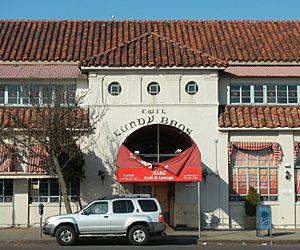
Sheepshead Bay uses two main ZIP Codes:
- 11229 for the area north of Avenue X.
- 11235 for the area south of Avenue X.
The United States Post Office has several locations nearby for mail services:
- Bay Station at 2628 East 18th Street.
- Homecrest Station at 2370 East 19th Street.
- Another Homecrest Station at 2302 Avenue U.
- Nostrand Station at 2934 Avenue X.
Education in Sheepshead Bay
Sheepshead Bay has many residents who have gone to college. About 47% of people here have a college degree or higher. This is more than the average for Brooklyn and New York City.
Students in Sheepshead Bay are doing well in math. The percentage of elementary school students who are good at math went up from 49% in 2000 to 66% in 2011. Reading scores stayed about the same.
Most high school students in Sheepshead Bay graduate on time. About 82% graduate on time, which is better than the city average of 75%.
Schools in the Neighborhood
Sheepshead Bay has several public schools:
- James Madison High School
- Abraham Lincoln High School
- JHS 14 Shell Bank Intermediate School
- The Bay Academy
- Elementary schools like P.S.194, PS 254, PS 206, PS 209, PS 225, and PS 52.
There are also private schools such as St. Mark Catholic Academy, St. Edmund's School, and the Brooklyn Amity School. Kingsborough Community College is also nearby.
Libraries for Learning
The Brooklyn Public Library has four branches in the Sheepshead Bay area:
- The Sheepshead Bay branch is at 2636 East 14th Street. It has been around since 1903.
- The Kings Bay branch is at 3650 Nostrand Avenue. It opened in 1951.
- The Kings Highway branch is at 2115 Ocean Avenue. It was the first library building built by New York City in Brooklyn. It also has a US Passport Office.
- The Homecrest branch is at 2525 Coney Island Avenue.
Madison Subsection
Madison is a part of Sheepshead Bay that is mostly homes. It's named after James Madison High School. Madison's boundaries are Kings Highway to the north, Avenue U to the south, Ocean Avenue to the west, and Nostrand Avenue to the east. Madison also uses the ZIP Code 11229.
Transportation in Sheepshead Bay
Public Transit Options
You can get to Sheepshead Bay using the New York City Subway's BMT Brighton Line (B and Q train train). There are local stops at Avenue U and Neck Road. There are also express and local stops at the Kings Highway and Sheepshead Bay stations.
Several New York City Bus routes serve the area, including the B3, B4, B36, B44, B44 SBS, B49, B68 local buses and the BM3 express bus.
Main Roads and Avenues
The main streets for shopping and businesses are Emmons Avenue, Sheepshead Bay Road, Avenue U, Ocean Avenue, and Nostrand Avenue.
Emmons Avenue is a special waterfront road. It has piers where you can find an active seafood market. You can also take tour boats from these piers for fishing trips or dancing. Emmons Avenue is at the western end of the Shore Greenway, a path that runs along the water.
Images for kids
-
Minor damage at Lundy's Restaurant due to Hurricane Sandy


